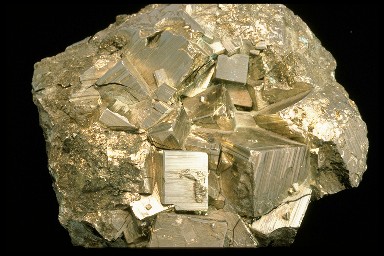Amethyst crystals from Brazil
Click on image for full size
Courtesy of Corel Photography
What Is a Mineral?
Minerals occur naturally on rocky planets and form the building blocks of rocks. They are non-living, solid, and, like all matter, are made of atoms of elements. There are many different types of minerals and each type is made of particular types of atoms. The atoms are bonded together and arranged in a special way called a crystal lattice, a network of atoms. The lattice of atoms is what gives a mineral its crystal shape.
Different types of minerals have different crystal shapes. Most minerals can grow into crystal shapes if they have enough space as they grow. But most of the time there are so many different crystals growing in the same space that they all compete for space and none of the crystals is able to grow very large.
There are two main ways that new crystals of minerals grow. Either they form when molten rock, called magma below a planetís surface and lava above, cools and changes state from a liquid to a solid allowing atoms to bond together into mineral crystals. Or, some minerals grow when water, that is rich with dissolved elements, evaporates and the atoms in the water get very close together, eventually bonding together forming solid minerals.
The special shapes of minerals are not the only difference between them. Minerals can be identified by other physical properties as well. Each type of mineral has its own unique set of characteristics.
Last modified January 24, 2008 by Lisa Gardiner.
You might also be interested in:

Any substance, called matter, can exist as a solid material, liquid, or gas. These three different forms are called states. Matter can change its state when heated. As a solid, matter has a fixed volume
...more
Everything you see around you is made of tiny particles called atoms, but not all atoms are the same. Different combinations of protons , neutrons and electrons make different types of atoms and these
...more
So far, over 2000 minerals have been found, and every year new ones are discovered. This is a pretty overwhelming number of different types of minerals, however, you don't need to know them all to be
...more
Magma consists of remelted material from Earth's crust and fresh material from the aesthenosphere, relatively near the Earth's surface. When magma is erupted onto the surface in the form of lava, it becomes
...more
An element (also called a "chemical element") is a substance made up entirely of atoms having the same atomic number; that is, all of the atoms have the same number of protons. Hydrogen, helium, oxygen,
...more
Each type of mineral is made of a unique group of elements that are arranged in a unique pattern. However, to identify minerals you donít need to look at the elements with sophisticated chemical tests.
...more
Are you going out to search for rocks and minerals? How will you know what types you have found? Identification guidebooks for rocks and minerals can be very helpful. Pick one that has nice color pictures
...more














